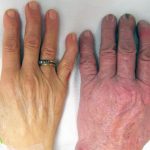 A blood disorder in which the blood is deficient in red blood cells and in haemoglobin.
A blood disorder in which the blood is deficient in red blood cells and in haemoglobin.
A reduction below normal in the number of erythrocytes per cu. mm., in the quantity of haemoglobin, or in the volume of packed red cells per 100 ml. of blood which occurs when the equilibrium between blood loss (through bleeding or destruction) and blood production is disturbed.
A shortage of red blood cells, leading to pallor and shortness of breath, especially on exertion. Most commonly due to a dietary deficiency of iron, or excessive blood loss. Other dietary deficiencies can also result in anaemia, including deficiency of vitamin B12 or folic acid (megaloblastic anaemia), vitamin E (haemolytic anaemia), and rarely vitamin C or vitamin B6.
Reduced number of red blood cells in the blood.
A condition in which the level of red blood cells is less than usual or where the haemoglobin is less, making it more difficult for the blood to carry oxygen. The symptoms are tiredness and pale colour, especially pale lips, nails and the inside of the eyelids. The condition can be fatal if not treated.
The condition characterised by inadequate red blood cells and/or haemoglobin in the blood. It is considered to exist if haemoglobin levels are below 13 grams per 100 ml in males and below 12 grams per 100 ml in adult non-pregnant women. No simple classification of anaemia can be wholly accurate, but the most useful method is to divide anaemias into: (a) microcytic hypochromic or iron deficiency anaemia; (4) megaloblastic hyperchromic anaemia; (c) aplastic anaemia; (d) haemolytic anaemia; (e) inherited anaemias.
A deficiency in the number of red blood cells or in the quantity of oxygen-carrying haemoglobin in these cells.
Anemia is a medical condition characterized by a lower-than-normal concentration of the oxygen-carrying pigment called hemoglobin in the blood. Hemoglobin molecules are housed within red blood cells and serve to transport oxygen from the lungs to the body’s tissues. The body typically maintains stable hemoglobin levels through a delicate equilibrium between the production of red blood cells in the bone marrow and their breakdown in the spleen. However, if this balance is disrupted, it can lead to the development of anemia.
Anemia is not a standalone disease but rather a characteristic found in numerous different disorders. It encompasses various types that can be classified based on two main categories: those resulting from reduced or impaired production of red blood cells in the bone marrow, and those arising from decreased lifespan of red blood cells within the bloodstream. The accompanying diagram presents an overview of the primary types of anemia.
The symptoms experienced in all forms of anemia stem from the diminished capacity of the blood to carry oxygen. The severity of these symptoms is contingent upon the extent to which the concentration of hemoglobin has decreased. Mildly reduced levels can result in fatigue and sluggishness. Significantly reduced levels can lead to difficulty breathing during physical exertion, dizziness due to inadequate oxygen supply to the brain, angina pectoris (chest pain caused by insufficient oxygen reaching the heart muscle), and palpitations as the heart exerts additional effort to compensate. General symptoms of anemia encompass paleness, particularly in the skin folds, the lining of the mouth, and the inner surface of the eyelids.
Certain forms of anemia may present additional features unique to each type. For instance, most cases of hemolytic anemia are accompanied by some degree of jaundice. This is due to the elevated rate of red blood cell breakdown, leading to an increased level of bilirubin, a yellow pigment produced during the breakdown of hemoglobin, in the bloodstream.
The diagnosis of anemia involves assessing the patient’s symptoms and conducting blood tests. In some cases, a bone marrow biopsy, which involves extracting a small sample of bone marrow for analysis, may be necessary to determine if there are any abnormalities in red blood cell production.
A decrease in the number of red blood cells in the blood.
